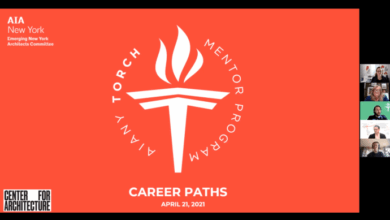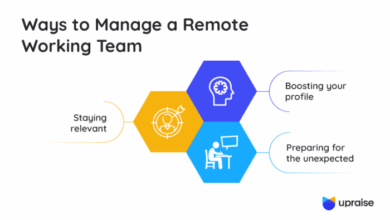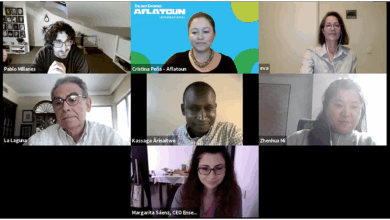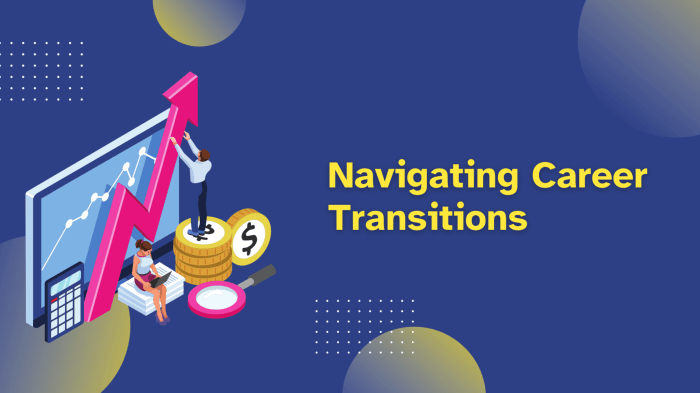
Embracing change navigating the shifting career landscape is crucial in today’s dynamic job market. The constant evolution of industries, fueled by technology and societal shifts, demands adaptability and a proactive approach. This isn’t just about finding a new job; it’s about developing a mindset and skillset for navigating the ever-changing career terrain.
This exploration delves into understanding the current career landscape, emphasizing the importance of a growth mindset, continuous learning, adaptability, and building a strong professional network. We’ll examine how to identify and leverage transferable skills, explore new opportunities, and successfully navigate the emotional aspects of career transitions. Get ready to discover practical strategies and actionable steps for thriving in a constantly evolving career path.
Understanding the Shifting Landscape
The modern career landscape is a dynamic and volatile environment. Gone are the days of predictable career paths; today’s professionals face constant adaptation and reinvention. Technological advancements, economic fluctuations, and evolving societal norms are reshaping industries at an unprecedented pace. This requires a proactive approach to career management, emphasizing adaptability and lifelong learning.The relentless pace of change demands a nuanced understanding of the forces driving this transformation.
From the rise of automation to shifts in consumer preferences, comprehending these influences is crucial for navigating the evolving job market successfully. This section delves into the multifaceted nature of these shifts, examining specific industry impacts and the potential consequences for individuals and organizations alike.
Factors Influencing Career Shifts
Understanding the various factors influencing career shifts is essential for navigating the modern job market effectively. The interconnectedness of these factors creates a complex interplay that requires a holistic approach to career planning.
- Technological Advancements: Automation and artificial intelligence are transforming numerous industries, impacting job roles and requiring employees to develop new skill sets. For instance, the rise of robotics in manufacturing has led to a decline in manual labor jobs, while creating new roles in robotics maintenance and programming.
- Economic Fluctuations: Economic downturns and recessions can lead to job losses and industry restructuring. Conversely, economic booms can create new opportunities in certain sectors. The recent COVID-19 pandemic, for example, caused widespread economic disruption, impacting numerous industries and creating both job losses and new opportunities in areas like telehealth and online commerce.
- Societal Changes: Shifting social values, cultural norms, and consumer preferences influence industry trends and job requirements. Increased awareness of environmental issues, for instance, has led to the growth of sustainable businesses and green jobs.
Industry Impacts and Potential Consequences
The following table illustrates the impact of these factors on various industries and potential consequences for professionals and businesses.
| Factor | Industry Impact | Potential Consequences |
|---|---|---|
| Technological Advancements | Retail: Increased use of e-commerce and automation in stores. Finance: Rise of robo-advisors and automated trading systems. Manufacturing: Adoption of automation and robotics. | Retail employees need to adapt to online sales and customer service. Financial professionals need to develop skills in data analysis and AI. Manufacturing workers need to acquire new technical skills. |
| Economic Fluctuations | Tourism: Fluctuations in travel demand. Construction: Economic downturns impact construction projects. Technology: Economic cycles affect investment in new technologies. | Tourism businesses need to adapt to changing travel patterns. Construction companies need to manage project timelines and budgets carefully. Technology companies need to adapt to market fluctuations. |
| Societal Changes | Healthcare: Increased demand for telehealth and preventative care. Fashion: Growing interest in sustainable and ethical fashion. Education: Demand for online learning and personalized education. | Healthcare professionals need to develop telehealth skills. Fashion designers need to focus on sustainability. Educators need to adapt to online learning methods. |
Cultivating a Growth Mindset
Embracing change in the dynamic career landscape requires more than just adaptability; it demands a proactive, growth-oriented mindset. This mindset, characterized by a belief in the power of learning and development, allows individuals to view challenges as opportunities for growth, rather than obstacles. Cultivating this mindset is crucial for navigating career transitions effectively and achieving lasting success.A growth mindset is essentially a belief that abilities and intelligence can be developed through dedication and hard work.
Navigating the ever-shifting career landscape requires embracing change, and that adaptability extends beyond our own professional paths. Think about the critical need for innovative solutions in global food security, like the biotech push needed to avert a looming crisis, as highlighted by scientists in this insightful article. Ultimately, the ability to adapt and embrace change in all its forms is a key skill in today’s dynamic world.
This contrasts with a fixed mindset, which assumes that abilities are static and predetermined. Individuals with a growth mindset are more likely to persevere through setbacks, seek out new challenges, and embrace learning experiences. This proactive approach to learning and development is essential in today’s rapidly evolving job market.
Importance of a Growth Mindset in Adaptability
A growth mindset fosters resilience and adaptability. When faced with a career shift or a new industry, individuals with a growth mindset are more likely to view the transition as an opportunity for learning and skill enhancement rather than a threat. They are more open to trying new things, seeking feedback, and taking on new responsibilities. This proactive approach allows them to navigate the uncertainties and complexities of the shifting landscape with greater confidence and effectiveness.
Strategies for Fostering a Growth Mindset
Developing a growth mindset is a journey, not a destination. It requires conscious effort and consistent practice. Several strategies can help cultivate this mindset in the face of career transitions:
- Embrace Challenges: Actively seeking out new challenges, even if they seem daunting, is a crucial step. This involves stepping outside your comfort zone and confronting situations that require learning and growth. Consistently pushing your limits allows you to discover new strengths and capabilities.
- View Feedback as a Tool: Constructive feedback, whether positive or negative, provides invaluable insights into areas for improvement. Individuals with a growth mindset actively seek out feedback and use it to refine their skills and knowledge.
- Persistence in the Face of Setbacks: Mistakes and setbacks are inevitable parts of any learning process. Individuals with a growth mindset view setbacks as opportunities to learn and adapt, rather than as indicators of failure.
- Focus on Learning, Not Just Results: A growth mindset emphasizes the process of learning over the outcome. This shift in focus allows individuals to embrace challenges with greater enthusiasm and resilience, knowing that the learning experience itself is valuable.
Examples of Individuals with a Growth Mindset
Numerous individuals have successfully navigated career shifts by embracing a growth mindset. For instance, successful entrepreneurs often demonstrate a willingness to learn from failures and adapt their strategies in response to market changes. Similarly, professionals who have transitioned to new industries have often done so by actively seeking out opportunities to acquire new skills and knowledge. These examples illustrate the power of a growth mindset in navigating the complexities of career transitions.
Actionable Steps to Develop a Growth Mindset
Transforming a fixed mindset into a growth mindset requires conscious and consistent effort. Here’s a practical list of actionable steps:
- Identify your current mindset: Reflect on your beliefs about your abilities and how you respond to challenges. This self-assessment is the first step toward change.
- Seek out feedback regularly: Actively solicit feedback from mentors, colleagues, and supervisors to identify areas for growth and improvement.
- Embrace challenges and mistakes as learning opportunities: Don’t shy away from new experiences or situations that require learning and development, even if they present risks or uncertainties.
- Develop a growth mindset mindset in your personal life: Extend the principles of a growth mindset to all areas of your life, fostering continuous learning and improvement.
- Surround yourself with growth-minded individuals: Learning from and interacting with people who embody a growth mindset can significantly impact your own development.
Embracing Continuous Learning
Staying relevant in today’s rapidly evolving job market demands a proactive approach to learning and skill development. No longer is a degree or a single set of skills sufficient to navigate a career path. Individuals must embrace continuous learning to adapt to new technologies, changing industries, and evolving job roles. This involves not just acquiring new skills but also adapting existing ones to fit the current demands.Continuous learning isn’t just about keeping up; it’s about proactively shaping your career trajectory.
It’s about recognizing your strengths and weaknesses, identifying areas needing improvement, and then actively seeking out opportunities to enhance your capabilities. This mindset of ongoing development leads to greater job satisfaction, improved earning potential, and a more secure future.
Learning Resources for a Shifting Landscape
Various resources are available to facilitate continuous learning. From structured online courses to practical workshops and mentorship programs, individuals have a wealth of options to enhance their skill sets. Finding the right resources depends on individual learning styles, career goals, and available time.
Identifying Learning Resources
A wide range of learning resources caters to diverse needs and preferences. Online platforms offer courses on virtually any topic, ranging from technical skills to soft skills. Workshops provide hands-on experience and networking opportunities, while mentorship programs offer personalized guidance from experienced professionals.
- Online Courses: Platforms like Coursera, edX, Udemy, and LinkedIn Learning offer a vast library of courses covering various disciplines. These courses are often flexible, allowing individuals to learn at their own pace and schedule. They are often affordable and accessible, making them a popular choice for continuous learning.
- Workshops and Seminars: These offer intensive, practical training in specific areas. They often include hands-on exercises, real-world case studies, and opportunities to connect with peers and industry experts. Workshops can be invaluable for acquiring specific skills quickly.
- Mentorship Programs: Pairing with a mentor who has experience in your desired field can provide invaluable guidance and support. Mentors offer personalized feedback, advice, and insights based on their professional journey, fostering career development in a tailored way. This often includes networking opportunities.
- Industry Events and Conferences: Attending industry events and conferences provides access to current trends, innovative solutions, and networking opportunities. These gatherings offer valuable insights and allow for direct interaction with leaders and experts.
Tailoring Learning to Career Needs
To effectively leverage learning resources, individuals should carefully tailor their learning paths to their evolving career needs. Understanding the specific skills and knowledge required in their current or desired roles is crucial. This involves assessing your current skill set, identifying skill gaps, and then choosing resources that address those gaps. This targeted approach ensures that learning efforts directly contribute to career advancement.
A Framework for Learning Resource Selection
This table provides a framework for selecting suitable learning resources based on various career paths:
| Career Path | Suitable Learning Resources | Rationale |
|---|---|---|
| Software Development | Online Courses (programming languages), Workshops (specific frameworks), Mentorship Programs (industry experts) | Developing cutting-edge software requires constant skill updates in programming languages and frameworks. Mentorship offers guidance on project management and practical application. |
| Marketing | Online Courses (digital marketing), Workshops (social media strategies), Industry Events (networking) | Marketing professionals need to stay abreast of digital marketing trends and adapt to evolving strategies. Industry events help build professional networks. |
| Project Management | Online Courses (project management methodologies), Workshops (risk management), Mentorship Programs (experienced PMs) | Project managers benefit from knowledge of different methodologies and practical experience in workshops. Mentors provide crucial insights into project execution and leadership. |
| Data Analysis | Online Courses (data visualization), Workshops (data analysis tools), Mentorship Programs (data scientists) | Data analysts must master data visualization techniques and specific tools. Mentorship provides valuable experience and guidance. |
Developing Adaptability and Resilience

The career landscape is constantly evolving, demanding a new set of skills from professionals. Adaptability and resilience are no longer desirable traits; they are essential for navigating the shifting sands of the modern job market. These qualities allow individuals to embrace change, bounce back from setbacks, and ultimately thrive in their chosen fields. This section explores the importance of these qualities and provides actionable strategies for cultivating them.The ability to adapt to new situations and absorb new knowledge is critical for career success in today’s dynamic environment.
Resilience, the capacity to recover from adversity, is equally vital. Both traits are intertwined and contribute significantly to a positive career trajectory. This discussion delves into practical strategies for developing both adaptability and resilience, and examines real-world examples of how individuals have overcome challenges and emerged stronger.
Importance of Adaptability and Resilience
Adaptability allows individuals to adjust their approaches and skillsets to meet the evolving demands of the workplace. Resilience empowers them to overcome obstacles and maintain a positive outlook during challenging times. Both are crucial for navigating career changes, whether it’s shifting roles within a company or pursuing entirely new career paths. They enable individuals to view setbacks as opportunities for growth and learning, fostering a proactive approach to career advancement.
Practical Strategies for Developing Adaptability
Cultivating adaptability involves embracing a growth mindset, actively seeking new knowledge and skills, and being open to different perspectives.
- Embrace Continuous Learning: Stay updated on industry trends, emerging technologies, and new approaches to your field. This constant learning fosters a willingness to adapt and experiment with new methods.
- Seek Feedback and Embrace Constructive Criticism: Actively solicit feedback from mentors, colleagues, and superiors. Use constructive criticism as an opportunity for improvement and refinement of your approach.
- Develop a Growth Mindset: View challenges as opportunities for growth and learning, rather than insurmountable obstacles. This mindset fosters a willingness to adapt and experiment.
- Build a Network of Mentors and Peers: Connect with individuals in your field who can offer guidance, support, and insights. A strong network provides valuable perspectives and opportunities for learning and adaptation.
Practical Strategies for Developing Resilience
Building resilience involves developing coping mechanisms for stress, fostering a positive outlook, and building a strong support system.
- Develop Coping Mechanisms: Identify and implement healthy coping strategies for stress and anxiety, such as exercise, mindfulness, or spending time in nature. These methods help manage emotional responses to challenging situations.
- Foster a Positive Outlook: Focus on your strengths and accomplishments, even during challenging times. This positive outlook fosters a greater ability to bounce back from setbacks.
- Build a Strong Support System: Maintain strong relationships with family, friends, and colleagues. This support network provides encouragement, emotional stability, and a sense of belonging.
- Practice Self-Care: Prioritize physical and mental well-being through healthy habits like adequate sleep, nutritious meals, and regular exercise. Self-care is essential for maintaining resilience and navigating stressful situations.
Examples of Resilience in Career Setbacks
Numerous individuals have demonstrated remarkable resilience in overcoming career setbacks.
- Example 1: A software engineer who lost their job during a company restructuring successfully leveraged their skills and experience to secure a position at a new company, leading to a promotion within a year.
- Example 2: A marketing professional who faced rejection after multiple job applications, persisted in their efforts, eventually landing a coveted position through networking and targeted job searches.
- Example 3: A project manager who experienced a significant project failure maintained a positive attitude and learned from the experience, subsequently leading to improved project management skills and a promotion.
Adapting to a New Career Path
This flowchart Artikels the process of adapting to a new career path:
| Step | Action |
|---|---|
| 1 | Identify Desired Career Path |
| 2 | Assess Current Skills and Knowledge |
| 3 | Identify Gaps in Skills and Knowledge |
| 4 | Develop Action Plan for Skill Enhancement |
| 5 | Seek Mentorship and Support |
| 6 | Practice New Skills |
| 7 | Apply for Relevant Positions |
| 8 | Adapt to New Role and Environment |
Building a Strong Professional Network: Embracing Change Navigating The Shifting Career Landscape
Navigating the ever-shifting career landscape requires more than just individual effort. A robust professional network can be a crucial asset, providing support, insights, and opportunities that might otherwise remain hidden. This network acts as a safety net, a sounding board, and a springboard for career advancement. Building and maintaining these connections is an active process, not a passive one.A strong professional network offers invaluable support in a changing job market.
Navigating the ever-shifting career landscape requires embracing change, and that includes understanding how technology impacts our professional lives. Technology, as we all know, is never neutral; it’s a powerful force shaping industries and roles in ways we often don’t fully grasp. This constant evolution, fueled by technology is never neutral , necessitates adaptability and a proactive approach to learning new skills.
Ultimately, embracing this change is key to thriving in a dynamic job market.
It provides access to knowledge, experience, and perspectives that can help individuals adapt to new challenges and seize emerging opportunities. Mentorship, collaboration, and referrals are all facilitated by these connections, ultimately empowering professionals to achieve their career goals.
The Value of Networking
A strong professional network is more than just a collection of contacts. It’s a dynamic ecosystem where individuals can share insights, support each other’s endeavors, and learn from each other’s experiences. This collaborative environment fosters innovation and growth, making it a crucial element in navigating the complexities of a changing career landscape.
Strategies for Networking, Embracing change navigating the shifting career landscape
Building a strong professional network requires a proactive and consistent approach. Attending industry events, joining professional organizations, and actively participating in online communities are effective strategies. Networking should not be a one-time event, but rather an ongoing process of nurturing relationships.
- Attending Industry Events: Industry conferences, workshops, and seminars provide excellent opportunities to connect with professionals in your field. Engage in conversations, exchange business cards, and follow up with individuals you meet. This is a chance to learn about the latest trends, meet potential mentors, and discover new career paths.
- Joining Professional Organizations: Membership in professional organizations provides access to a network of like-minded individuals. Participating in their activities, attending meetings, and contributing to discussions will help you build relationships and expand your professional horizons.
- Leveraging Online Platforms: Online platforms such as LinkedIn, Twitter, and industry-specific forums can be powerful tools for networking. Actively engaging in these communities through thoughtful posts, insightful comments, and targeted connections will help you establish yourself as a knowledgeable and engaging professional.
Networking in Different Fields
Expanding your network to include professionals in diverse fields can offer unique perspectives and lead to unexpected opportunities. For example, connecting with someone in marketing could provide valuable insights into a completely different sector. Don’t limit your networking to just your current field; explore connections with professionals in related or complementary areas.
- Reaching Out to Mentors: Seeking mentorship from experienced professionals can be a great way to accelerate your career development. Mentors can provide guidance, advice, and support, helping you navigate challenges and seize opportunities.
- Building Relationships with Colleagues: Even colleagues outside of your direct team can become valuable contacts. Building rapport with colleagues in different departments or roles can lead to unexpected collaboration opportunities and provide new insights into your industry.
Networking Examples
Networking has been instrumental in helping individuals secure new opportunities. A software engineer, for example, who actively participated in industry events and online communities was able to secure a senior position at a startup through a referral from a connection made at a conference. This highlights the power of consistent networking efforts in opening doors to new opportunities.
- Building Referrals: Networking can create a system of referrals, providing opportunities that might not otherwise arise. By building relationships with professionals in your industry, you can create a network that can help you find new employment opportunities.
- Expanding Your Knowledge Base: Networking provides access to a wealth of knowledge and experience, which is critical in navigating a constantly evolving career landscape. By connecting with professionals in different fields, you gain a wider understanding of your industry and other related areas, leading to new perspectives.
Leveraging Online Platforms
Online platforms like LinkedIn provide a virtual space for networking and professional development. Building a strong LinkedIn profile, participating in relevant groups, and engaging with industry leaders are effective strategies. These platforms offer a convenient and accessible way to connect with professionals globally.
- LinkedIn: Building a strong LinkedIn profile is crucial for online networking. Highlight your skills, experience, and achievements to attract potential connections and opportunities. Actively engaging in relevant groups and discussions demonstrates your interest in the field and strengthens your professional presence.
- Industry Forums: Participating in industry forums and online communities allows you to engage with professionals, ask questions, share insights, and learn from others’ experiences.
Skill Sharpening and Transferability
Navigating the ever-shifting career landscape requires a proactive approach to skill development. Simply acquiring knowledge isn’t enough; understanding how those skills translate across different industries and roles is crucial for career agility. This section delves into the art of skill sharpening and transferability, empowering you to identify, demonstrate, and continually update your skillset for long-term success.Transferable skills are abilities and competencies that are valuable across various industries and job roles.
These aren’t limited to technical skills but also encompass soft skills, such as communication, problem-solving, and teamwork. Identifying and honing these transferable skills can significantly enhance your career prospects in a dynamic job market.
Identifying Transferable Skills
Transferable skills are abilities and competencies that can be applied to various industries and job roles. They often fall into categories like communication, problem-solving, time management, and leadership. Recognizing these skills within your current and past experiences is a key first step. For example, if you managed a project in your previous role, you likely demonstrated organizational, planning, and problem-solving skills, all of which are valuable across many industries.
Demonstrating Transferable Skills
Effectively showcasing transferable skills in a new role requires tailoring your resume and interview responses. Quantify your achievements whenever possible. Instead of saying “Managed a project,” state “Managed a project for X clients, resulting in a Y% increase in sales.” This quantifiable approach provides concrete evidence of your abilities. Highlighting specific projects and achievements that showcase your skills in action is essential.
Continuous Skill Set Updates
Staying relevant in today’s rapidly evolving job market necessitates continuous learning and skill development. The skills in high demand today might be different from those sought after in the past. Industries are constantly changing, and new technologies emerge frequently, necessitating adaptation and continuous learning. For instance, proficiency in data analysis is highly sought after in many sectors today, a skill that wasn’t as crucial a decade ago.
Identifying In-Demand Skills
Identifying current in-demand skills requires staying informed about industry trends and emerging technologies. Following industry news, attending webinars, and participating in online courses can keep you abreast of the latest advancements. For example, a rise in automation in manufacturing necessitates employees to develop skills in robotics and AI to effectively collaborate with these systems. This proactive approach to identifying future needs is vital for career longevity.
Exploring New Opportunities and Career Paths
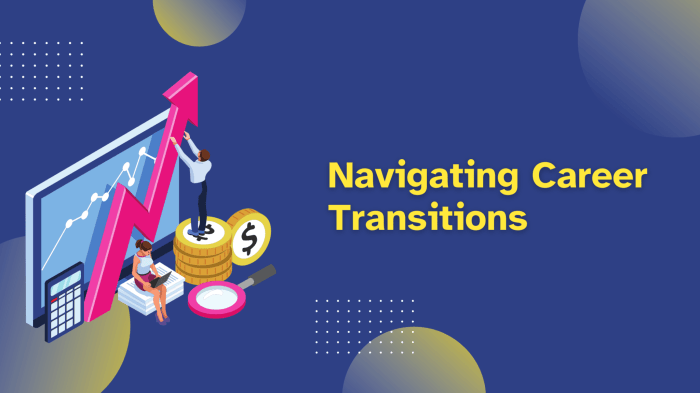
Embarking on a new career path can be daunting, but also incredibly rewarding. The modern job market is dynamic, and recognizing the need to adapt and explore new avenues is crucial for long-term career success. This exploration isn’t just about finding a different title; it’s about aligning your skills and passions with emerging opportunities.The journey of career exploration is multifaceted.
Embracing change in the ever-shifting career landscape is key, but sometimes a bit of outside perspective helps. Just like the recent tech news, where Natal drops jaws and Nvidia shines, pre-setting a new bar in the industry, this news cycle reminds us that adapting and innovating are crucial for staying relevant. Ultimately, we all need to be open to adjusting our strategies and embracing new opportunities to navigate this evolving career terrain.
It demands introspection, research, and a willingness to step outside your comfort zone. This involves understanding your strengths, weaknesses, interests, and values, and how they might translate into a new field. This section will Artikel strategies for this process, highlighting the importance of self-assessment and career counseling, and offering examples of successful transitions.
Strategies for Exploring New Career Paths
Identifying new career paths requires proactive steps. Researching emerging industries and roles is a fundamental aspect. Staying informed about industry trends, technological advancements, and evolving job markets through reputable sources like industry publications and online resources will provide valuable insights. Networking with professionals in fields you’re considering is also crucial. Attending industry events, joining online forums, and connecting with people on professional platforms can offer invaluable guidance and open doors to new possibilities.
The Significance of Self-Assessment and Career Counseling
Self-assessment is paramount in this process. Understanding your strengths, weaknesses, interests, and values provides a solid foundation for identifying potential career paths that align with your aspirations. A career counselor can act as a guide, providing objective insights and tailored advice based on your individual profile. They can help you clarify your career goals, identify transferable skills, and develop a personalized action plan for exploration.
Examples of Successful Career Transitions
Numerous individuals have successfully transitioned to new careers. A software engineer, for instance, might transition into project management after developing strong leadership skills during their software development roles. Their technical expertise becomes a valuable asset in a new capacity. Similarly, a marketing professional might transition into a business development role, leveraging their strong communication and relationship-building skills. These examples demonstrate the adaptability and transferable skills often present in professionals.
A Decision-Making Framework for Exploring Career Alternatives
A structured approach is essential for navigating the complexity of career choices. This framework involves several key steps:
- Identifying Interests and Values: Understanding your passions and what motivates you is crucial. What tasks do you find inherently engaging? What values are important to you in a career? This initial step helps narrow down possible paths.
- Assessing Skills and Experiences: Evaluate your existing skills and work experience. What are your strong points? What skills are transferable to different fields? Consider how your experiences can contribute to a new role.
- Researching Potential Career Paths: Explore different career options that align with your interests and skills. Investigate job descriptions, required qualifications, and industry trends.
- Networking and Information Gathering: Connect with professionals in the fields you’re interested in. Seek insights from mentors, industry experts, and current professionals.
- Trial and Experimentation: Consider options for trial periods, such as internships, volunteer work, or freelance projects. This allows for hands-on experience and clarifies your fit within the new field.
Navigating the Transition Process
Embarking on a career transition can be a rollercoaster of emotions. From excitement and anticipation to fear and uncertainty, the journey often involves navigating a complex interplay of personal and professional challenges. Understanding the emotional landscape and developing coping mechanisms is crucial for a smooth and successful transition. This process isn’t linear; it’s about embracing the ups and downs, learning from each experience, and ultimately, emerging stronger.The career transition process is not just about finding a new job; it’s about adapting to a new reality.
This involves significant personal and professional adjustments, impacting self-image, identity, and sense of purpose. It’s essential to acknowledge the emotional toll and equip oneself with strategies to manage the associated anxieties. Recognizing and addressing these emotions is a key step towards navigating the transition effectively.
Emotional and Psychological Aspects of Career Transitions
Career transitions often trigger a range of emotions, from excitement and motivation to anxiety, fear, and even depression. These emotions are normal and a natural response to change. Understanding these feelings and acknowledging their validity is the first step towards managing them effectively. Recognizing the emotions associated with career transitions allows for more targeted and empathetic self-care.
Importance of Self-Care and Well-being
Maintaining well-being during a career transition is not a luxury but a necessity. Self-care encompasses a variety of activities aimed at nurturing physical, mental, and emotional health. Prioritizing activities that promote relaxation, stress reduction, and a sense of accomplishment can significantly impact the overall experience. This involves consciously making time for activities that bring joy and relaxation.
Practical Tips for Managing Stress and Anxiety
Effective stress management is crucial during a career transition. Developing healthy coping mechanisms can significantly reduce the impact of anxiety and stress. Techniques like mindfulness meditation, deep breathing exercises, and engaging in hobbies can help individuals manage their stress levels effectively. Consistent practice of these methods can create a buffer against the emotional turbulence often associated with career changes.
Also, seeking support from mentors, colleagues, or therapists can be a valuable strategy.
Stages of Career Transition and Strategies for Managing Each Stage
Career transitions typically involve several stages, each with its own set of challenges and opportunities.
- Exploration and Assessment: This initial phase involves self-reflection, identifying desired career paths, and assessing current skills and knowledge. This phase requires a thorough understanding of your values, aspirations, and strengths to define a clear career vision. This clarity helps guide future decisions.
- Preparation and Planning: This stage focuses on acquiring necessary skills, building a strong network, and developing a comprehensive job search strategy. This includes updating your resume, refining your interview skills, and proactively identifying potential opportunities. The preparation phase lays the foundation for a successful transition.
- Implementation and Action: This phase involves actively pursuing new opportunities, networking, and engaging in job applications. Active participation in job fairs, informational interviews, and attending relevant events can greatly increase your chances of success. Proactive application of developed strategies is crucial during this phase.
- Adjustment and Integration: This stage involves settling into the new role, adapting to the new work environment, and integrating new skills and knowledge. Building positive relationships with colleagues, seeking mentorship, and actively participating in team activities can contribute to a smooth integration process. Embracing new responsibilities is critical for success during this phase.
Ultimate Conclusion
In conclusion, embracing change navigating the shifting career landscape requires a multifaceted approach. By understanding the current environment, cultivating a growth mindset, and prioritizing continuous learning, adaptability, and networking, individuals can effectively navigate transitions and thrive in their careers. The key takeaway is to be proactive, adaptable, and resilient, always seeking opportunities for growth and development. Ultimately, embracing change is not just about surviving, but about thriving in this evolving world of work.

